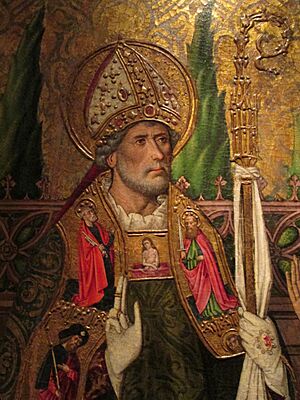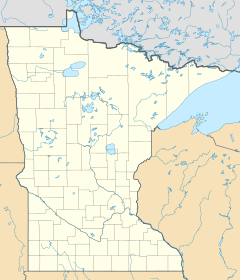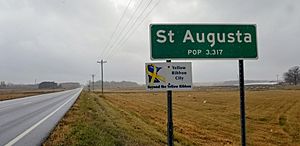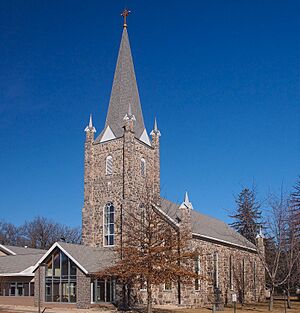St. Augusta, Minnesota facts for kids
Quick facts for kids
St. Augusta
|
|
|---|---|
|
City
|
|
| Motto(s):
"Where Country Meets Community"
|
|
| Country | United States |
| State | Minnesota |
| County | Stearns |
| Settled | 1854 |
| Organized | 1859 |
| Incorporated | May 2, 2000 |
| Area | |
| • Total | 29.84 sq mi (77.28 km2) |
| • Land | 29.68 sq mi (76.88 km2) |
| • Water | 0.15 sq mi (0.40 km2) |
| Elevation | 1,030 ft (310 m) |
| Population
(2020)
|
|
| • Total | 3,497 |
| • Estimate
(2021)
|
3,574 |
| • Density | 117.80/sq mi (45.48/km2) |
| Time zone | UTC-6 (CST) |
| • Summer (DST) | UTC-5 (CDT) |
| ZIP codes |
56301
|
| Area code(s) | 320 |
| FIPS code | 27-56752 |
| GNIS feature ID | 2396474 |
Saint Augusta, also called St. Augusta, is a city in Stearns County, Minnesota, United States. It is located just south of the city of St. Cloud. In 2020, about 3,497 people lived there.
St. Augusta is part of the larger St. Cloud area.
Contents
History of St. Augusta

In the mid-1800s, a missionary named Father Francis X. Pierz encouraged Catholic families to move to central Minnesota. Many immigrants from Germany, Slovenia, and Poland came to settle here. They built over 20 churches in what is now Stearns County. These churches became the centers of small towns.
One of these churches was St. Mary, Help of Christians. It was built in 1873. Stearns County still has a strong German heritage and many Catholic residents.
How St. Augusta Got Its Name
St. Augusta got its name in a special way. Father Pierz found a German holy card (a small picture of a saint) of St. Augustine in a field. This field was where they planned to build their church. Father Pierz suggested naming the town after the saint. The town's name was slightly changed over time, but the original holy card is still kept in the church's records.
Community and Military Service
Like other German communities in Stearns County, St. Augusta has always had people join the United States military. They have served in every war, from the American Civil War to today. This includes the World Wars, even though those wars were fought against Germany, their ancestors' homeland.
Every Memorial Day, the local American Legion group holds ceremonies. They visit the three cemeteries in the city. During these ceremonies, they read the names of all the local veterans who have passed away.
From Township to City
St. Augusta was first known as Saint Augusta Township. It officially became a city on May 2, 2000. This was done to prevent the larger city of St. Cloud from taking over its land. The city was named after a local church in the 1850s.
One important historical building in St. Augusta is the St. Mary Help of Christians Church, built in 1873. Its rectory (the priest's house) from 1890 is also important. Both are listed on the National Register of Historic Places.
For a short time, St. Augusta was called Ventura, after the governor at the time, Jesse Ventura. But the people voted to change it back to Saint Augusta. This official change happened on November 7, 2000.
St. Boniface Chapel & Pilgrimage Shrine
The Christian pilgrimage shrine known as St. Boniface Chapel was built in 1877. It was built because of a serious problem: giant grasshoppers called Rocky Mountain locusts. These insects would fly in huge swarms, blocking out the sun. They destroyed crops and caused great hardship for farming communities across North America.
The Locust Plague and a Promise
In 1874, there was a terrible locust plague that lasted four years. These insects ate everything, including crops and even clothes. Many families lost all their food and crops. People tried to fight the insects, but there were too many. They felt they needed help from above.
The people of St. Augusta and a nearby area called Luxemburg made a promise. They vowed to build a chapel and make a pilgrimage (a special journey) to it every year. They would pray that such plagues would never happen again.
A local farmer, Henry Kaeter, gave land for the chapel. It was on a small hill between their churches. One person, Ignatz Henkemeyer, remembered, "The grasshoppers were real bad. Everything dried up. After we finished at St. Boniface's, the rain started to fall, and all the hoppers flew up and disappeared."
Annual Pilgrimages and Traditions
For many years, people continued the annual pilgrimages to the shrine. They went on June 5, which is the Feast Day of St. Boniface. He was an English missionary who helped spread Christianity among the German people. He is still known as the "Apostle to the Germans" and a Patron Saint of German-speaking people.
During the pilgrimages, women decorated the chapel with flowers. Choirs sang, sometimes bringing an organ. Many people, almost every family, came. They walked, some as far as six miles, in pairs, saying the rosary (a series of prayers). A large wagon carried their lunch.
It was a tradition in Stearns County German culture to add a special prayer during the rosary on St. Boniface's Day. After each "Hail Mary" prayer, they would add, "St. Boniface, pray for us!"
Ignatz Henkemeyer also recalled, "When the people came up the hill, singing all the way, it looked like a long train."
Community Gatherings and Music
These pilgrimages often ended with a special outdoor dinner at the chapel. There was dancing and German folk music was played and sung. This was a continuation of old traditions from Germany, like parish feast day picnics.
These celebrations were informal and happened on holidays like Christmas and New Year's Day, and after the harvest. Pastors always attended. People would tell stories or sing old German songs. Popular songs included Muss i denn and O du lieber Augustin. It was common for local veterans of the American Civil War to sing Ich hatt' einen Kameraden, a sad soldier's song, to remember their friends.
The Chapel's Restoration
After 1897, the pilgrimages stopped, and the chapel was left alone and forgotten. People who had made the original promise were either gone or too old to go. Their children did not feel the same obligation.
In 1937, Martin Libbesmeier bought the Henry Kaeter farm. He found the old, broken chapel. He moved the ruins to his yard, where they stayed for 29 years. Over time, parts of the chapel, like the crucifix and a statue, broke and were buried.
In 1958, Father Severin Schwieters became the priest at St. Mary Help of Christians Church. He convinced his church members that the chapel was an important part of their history and needed to be fixed. They moved the ruins to a wooded hill near the original spot. They rebuilt it using as much of the original wood and materials as possible. Another church donated a new altar and other items. By St. Boniface's Day in 1961, the chapel was ready. The annual pilgrimages sometimes still happen today.
The Rocky Mountain locusts, the insects that caused the original plague, were last seen in 1902. In 2014, they were officially declared extinct.
Geography
The United States Census Bureau says that St. Augusta covers about 29.81 square miles (77.21 square kilometers). Most of this area is land, and a small part is water.
Minnesota State Highway 15 and County Route 7 are two main roads in St. Augusta. Interstate 94/U.S. Highway 52 and County Route 75 are near the city's northeast edge. The city of Saint Cloud is directly north and northeast of St. Augusta.
Population and People
| Historical population | |||
|---|---|---|---|
| Census | Pop. | %± | |
| 1880 | 798 | — | |
| 1890 | 791 | −0.9% | |
| 1900 | 819 | 3.5% | |
| 1910 | 766 | −6.5% | |
| 1920 | 821 | 7.2% | |
| 1930 | 949 | 15.6% | |
| 1940 | 968 | 2.0% | |
| 1950 | 904 | −6.6% | |
| 1960 | 1,056 | 16.8% | |
| 1970 | 1,584 | 50.0% | |
| 1980 | 2,169 | 36.9% | |
| 1990 | 2,657 | 22.5% | |
| 2000 | 3,065 | 15.4% | |
| 2010 | 3,317 | 8.2% | |
| 2020 | 3,497 | 5.4% | |
| 2021 (est.) | 3,574 | 7.7% | |
| U.S. Decennial Census 2020 Census |
|||
Population in 2010
In 2010, there were 3,317 people living in St. Augusta. There were 1,154 households and 937 families. The city had about 111.8 people per square mile.
Most of the people (97.4%) were White. There were also small numbers of African American, Native American, and Asian residents. About 0.6% of the population was Hispanic or Latino.
The average age in the city was 36.6 years old. About 27.1% of residents were under 18. About 13.2% of households had people living alone. The average household had 2.86 people.
Education
Most of St. Augusta is part of the St. Cloud Area School District. A smaller part is in the Kimball Public School District.
Three elementary schools serve parts of St. Augusta within the St. Cloud district: Clearview, Discovery, and Oak Hill. All students in the St. Cloud school district part of St. Augusta attend South Middle School and Technical Senior High School.
See also
 In Spanish: St. Augusta (Minnesota) para niños
In Spanish: St. Augusta (Minnesota) para niños




